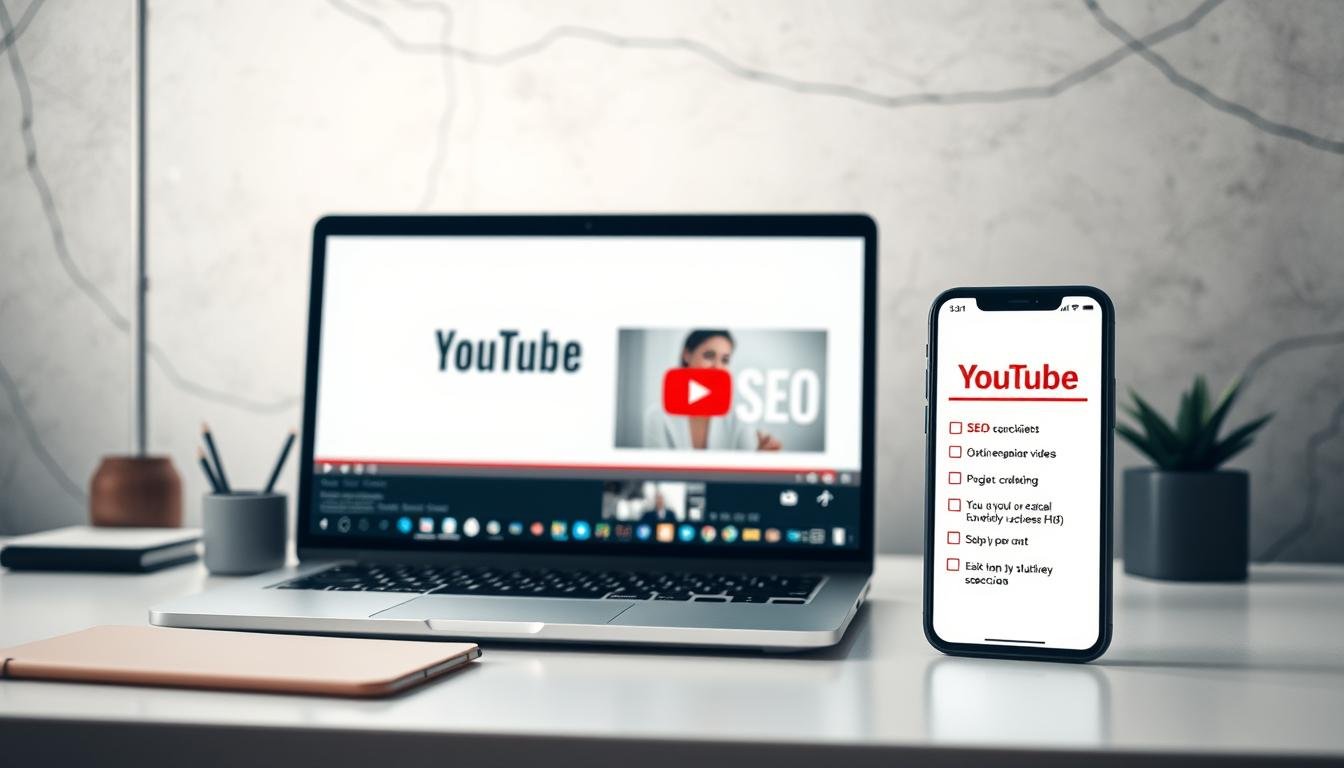Did you know that over 500 hours of video content are uploaded every minute? With such a saturated platform, how can you ensure your videos stand out and reach your target audience? The answer lies in understanding and leveraging the platform’s algorithm to your advantage.
YouTube operates as a search engine, prioritizing factors like watch time, click-through rates, engagement, and metadata. To succeed, you need a comprehensive strategy that aligns with these ranking signals. This guide will walk you through the essential steps to optimize your video content for better visibility and performance.
From crafting compelling titles and descriptions to designing eye-catching thumbnails, every detail matters. By focusing on both technical optimization and audience retention strategies, you can boost your search rankings and grow your viewership. Ready to transform your video content? Let’s dive in.
Key Takeaways
- Over 500 hours of video content are uploaded to the platform every minute.
- YouTube’s algorithm prioritizes watch time, CTR, engagement, and metadata.
- A comprehensive checklist ensures your videos stand out in a competitive space.
- Optimize titles, descriptions, tags, and thumbnails for better search rankings.
- Focus on both technical optimization and audience retention strategies.
- Real-world case studies show significant growth in views using this approach.
What is YouTube SEO and Why It Matters
With millions of videos uploaded daily, standing out requires more than just great content. Strategic optimization, often referred to as YouTube SEO, is essential for improving search visibility and getting your videos recommended. This process involves aligning your content with the platform’s algorithm to maximize reach and engagement.
Understanding YouTube’s Algorithm
The platform’s algorithm prioritizes viewer satisfaction. Metrics like watch time and engagement play a crucial role in determining rankings. For instance, videos that retain at least 50% of viewers are more likely to perform well. Additionally, click-through rates (CTR) are heavily influenced by titles and thumbnails, making them critical for success.
Other core ranking signals include comments, shares, subscribes, session duration, video length, and thumbs up/down. By focusing on these factors, you can improve your video’s performance and visibility.
Key Benefits of Optimizing Your Videos
Optimizing your channel can lead to significant benefits. Studies show that properly optimized videos can see a 30-50% traffic boost from Google video carousels. Additionally, adding captions can increase views by up to 80%, making your content more accessible and engaging.
By leveraging these strategies, you not only enhance your video’s visibility but also create a better experience for your audience. This dual focus on technical optimization and viewer satisfaction is the key to long-term success.
Step 1: Conduct Thorough Keyword Research
Finding the right keywords is the foundation of video success. Without proper keyword research, your content may get lost in the sea of videos. Start by identifying phrases your audience is searching for. This ensures your videos align with their needs and interests.
Using Autocomplete for Instant Suggestions
One of the simplest ways to find relevant phrases is by using the platform’s autocomplete feature. Type a general term like “how to” and let the suggestions guide you. These results reflect real-time search trends, making them a valuable resource for your strategy.
Analyzing Competitor Keywords
Studying your competitors can reveal gaps in your content. Tools like VidIQ allow you to scrape tags from top-performing videos. This helps you understand what works and how to target similar audiences effectively.
Leveraging Keyword Research Tools
For deeper insights, use tools like SEMrush or Google Trends. SEMrush provides data on search volume and competitiveness, while Google Trends highlights trending topics. Compare these tools to find the best fit for your needs.
Focus on long-tail keywords like “beginner yoga for back pain” instead of generic terms. These phrases have lower competition and higher intent. Avoid high-competition keywords by analyzing the “About results” section. This ensures your efforts yield maximum results.
Step 2: Optimize Your Video Titles
Your video title is the first thing viewers see, making it a critical element for success. A well-crafted title not only grabs attention but also improves your video’s visibility in search results. To achieve this, focus on clarity, relevance, and strategic keyword placement.
Incorporate Your Main Keyword
Start by placing your primary keywords in the first 25 characters of the title. Research shows that titles with this placement perform 17% better in search rankings. For example, instead of “Gardening Tips,” use “7 Organic Gardening Tips for Small Spaces.” This approach ensures your content aligns with what viewers are searching for.
Keep Titles Clear and Engaging
An effective title balances clarity with creativity. Aim for 50-60 characters to ensure it’s fully visible in search results. Use power words like “Ultimate,” “Proven,” or “Step-by-Step” to make your title stand out. Including numbers, such as “5 Minute” or “2024 Guide,” can also boost click-through rates.
Avoid misleading or clickbait titles, as they can harm your video’s performance. Instead, focus on delivering value and accuracy. Test different titles using YouTube Analytics to identify which ones resonate most with your audience. This data-driven approach ensures your titles consistently attract viewers and drive engagement.
Step 3: Craft Compelling Video Descriptions
Your video description is a powerful tool to boost visibility and engagement. It’s not just a summary of your content; it’s an opportunity to connect with your audience and improve search rankings. The first 120 characters are especially crucial, as they appear in preview text and can determine whether viewers click on your video.
Include Keywords Naturally
Integrate your main terms seamlessly into the description. For example, “This acrylic painting tutorial demonstrates step-by-step techniques for beginners.” Avoid keyword stuffing, as it can harm your video’s performance. Instead, focus on providing value while naturally incorporating relevant phrases.
Use semantic variations of your primary keyword to enhance your strategy. Tools like Google Keyword Planner can help identify related terms. This approach ensures your description aligns with what viewers are searching for.
Add Links and CTAs
Include links to related blog posts, product pages, or other videos to keep viewers engaged. For instance, “Check out our blog for more painting tips.” Effective calls to action (CTAs) like “Subscribe for weekly art tutorials” outperform generic prompts like “Subscribe now.”
Structure your description with a clear format: start with a hook, highlight key points, add timestamp links, and end with a CTA. This text structure improves readability and encourages viewers to take action. By following these steps, you can craft descriptions that maximize your video’s visibility and impact.
Step 4: Use Tags Strategically
Tags play a crucial role in enhancing your video’s discoverability. They help the platform understand your content and connect it with relevant searches. However, using them effectively requires a strategic approach.
Add Relevant Tags
Start by creating a tag hierarchy. Your primary tag should match the exact keyword, while secondary tags can include variations. For example, if your video is about “beginner yoga,” use that as the primary tag and add related terms like “yoga for flexibility” or “easy yoga poses.”
Analyze competitors using tools like TubeBuddy to identify effective tags. Mirroring tags from top-ranking videos in your niche can improve your chances of appearing in Suggested Videos. Additionally, include location-based tags like “NYC food tours” if relevant to your content.
Avoid Overstuffing
One common mistake is repeating the same tag multiple times. This doesn’t improve your video’s performance and can harm its visibility. Stick to the 400-character limit and focus on a mix of broad and niche tags.
For brand protection, add your channel name as the final tag. This ensures your content is associated with your brand, even if it’s shared outside the platform. By following these tips, you can maximize the impact of your tags and boost your seo efforts.
Step 5: Create Eye-Catching Thumbnails
A thumbnail is often the first impression your video makes on potential viewers. With custom thumbnails increasing click-through rates by 42%, it’s clear that this small visual element can have a big impact. To stand out, your thumbnail must be visually appealing, relevant, and optimized for both desktop and mobile devices.
Design Tips for Thumbnails
Start with a template in tools like Canva. Use bold text in Impact font and contrasting colors to grab attention. Facial close-ups are highly effective, as they create an emotional connection with viewers. Keep the design simple—no more than five words and ensure 98% mobile legibility.
High-contrast designs, like those used by MrBeast, are proven to attract clicks. On the other hand, minimalist styles, such as Marques Brownlee’s, appeal to a more niche audience. Choose a style that aligns with your brand and content.
Test Thumbnails for CTR
Testing is crucial to determine what works best. Use YouTube’s A/B testing feature or third-party tools like Thumbnail Test to compare different designs. Analyze metrics like click-through rates and engagement to refine your approach.
Avoid misleading imagery, as it can lead to penalties under the platform’s “Shock Content” policy. Instead, focus on creating thumbnails that accurately represent your video’s content. Tools like Remove.bg for background removal and Unsplash for royalty-free images can streamline the design process.
By following these tips and leveraging the right resources, you can create thumbnails that boost your video’s visibility and attract more viewers.
Step 6: Add Captions and Subtitles
Captions and subtitles are more than just accessibility tools—they’re a secret weapon for boosting engagement and discoverability. With 85% of videos watched without sound, adding captions ensures your content reaches a wider audience. Plus, they can improve seo by making your video’s text indexable in search results.
Improve Accessibility and SEO
Manual captions can boost watch time by 15%, making them a valuable addition to your strategy. Unlike auto-captions, which often contain errors, human transcriptions from services like Rev.com ensure accuracy. This precision enhances viewer experience and helps your content rank higher.
Use Accurate Transcriptions
For tutorials or educational content, captions provide an additional layer of value. Platforms like Otter.ai offer AI-powered transcription tools, while YouTube Studio allows you to edit auto-captions for better accuracy. A tech channel saw a 22% retention boost after refining their captions, proving their impact.
Don’t forget multilingual audiences. Adding Spanish subtitles, for example, can tap into diverse markets. By leveraging these tools and strategies, you can make your videos more accessible, engaging, and discoverable.
Step 7: Organize Videos with Playlists
Organizing your video content into playlists can significantly enhance viewer experience and engagement. Playlists help viewers find related videos easily, encouraging them to stay on your channel longer. This not only boosts watch time but also signals to the algorithm that your content is valuable.
Group Related Content
Start by grouping videos that share a common theme. For example, a cooking channel might create a playlist titled “30-Minute Meals.” Use clear naming conventions like “Digital Marketing Fundamentals [2024 Playlist]” to make it easy for viewers to understand the content. Sequencing videos from beginner to advanced levels can also improve the viewing experience.
Boost Watch Time
Playlists increase average view duration by 28%, making them a powerful tool for retaining viewers. Custom playlist thumbnails can improve click-through rates compared to auto-generated ones. Track the “Playlist Starts” metric in your analytics to measure success. For instance, one cooking channel found that their “30-Minute Meals” playlist generated 40% of their total views.
Cross-promote playlists by linking them in video end screens. This encourages viewers to explore more of your content and keeps them engaged. By implementing these strategies, you can maximize your watch time and grow your channel effectively.
Step 8: Promote Your Videos Across Platforms
Expanding your video’s reach beyond the platform can significantly boost engagement and traffic. By leveraging multiple channels, you can attract a wider audience and keep them engaged with your content. Here’s how to effectively promote your videos across different platforms.
Share on Social Media
Social media is a powerful tool for increasing your video’s visibility. Tailor your approach to each platform. For example, create short teasers for TikTok and thought leadership clips for LinkedIn. This ensures your content resonates with the audience on each platform.
Platform-specific strategies can make a big difference. A case study showed that sharing video links on Reddit during an AMA session resulted in a 3x boost in traffic. Similarly, integrating video thumbnails into email campaigns using tools like Mailchimp can drive higher engagement.
Embed Videos in Blog Posts
Embedding videos in blog posts can enhance your website’s value and keep visitors engaged longer. Studies show that embedded videos increase blog dwell time by 2 minutes. To maximize impact, add timestamp links in WordPress to guide viewers to specific sections of the video.
Repurposing videos into Medium articles with embedded clips is another effective tactic. This not only extends your content’s lifespan but also taps into Medium’s large user base. Collaborating with complementary channels for guest video appearances can also expand your reach and attract new viewers.
By strategically promoting your videos across platforms, you can amplify their impact and grow your audience effectively.
Step 9: Analyze and Optimize Performance
Understanding your video’s performance is key to refining your strategy and achieving better results. By tracking key metrics and making data-driven adjustments, you can enhance your video’s visibility and engagement.
Track Key Metrics in YouTube Analytics
Start by focusing on three critical metrics: audience retention, click-through rate (CTR), and traffic sources. Aim for an audience retention rate above 50%, as this signals that viewers are engaged with your content. A CTR between 3-10% is ideal, indicating that your titles and thumbnails are effective.
Analyzing traffic sources helps you understand where your views are coming from. For example, if “Suggested Videos” is your second-largest source, it means your content is being recommended by the platform. Use tools like VidIQ or TubeBuddy to track these metrics and identify trends.
Adjust Strategies Based on Data
Once you’ve gathered data, it’s time to optimize. For instance, if you notice a drop-off at the 2:30 mark in your video, consider editing that section to maintain viewer interest. Test two different thumbnails and analyze which one yields a higher CTR. A tech reviewer increased their CTR by 37% simply by adding red arrows to their thumbnails.
Conduct quarterly audits to update titles and descriptions of underperforming videos. This ensures your content remains relevant and aligned with current search trends. By continuously refining your approach, you can improve your video’s search rankings and overall performance.
Conclusion
Mastering video optimization is essential for standing out in a crowded digital space. By following the 9-step framework—focusing on keyword research, thumbnails, and consistent uploads—you can grow your channel effectively. Aim for at least one video per week to stay favored by the algorithm.
Avoid outdated tactics like Sub4Sub or misleading tags, as they harm your visibility. Instead, embrace emerging trends, such as integrating Shorts into your strategy, to reach a broader audience.
For a comprehensive guide, download our free checklist to improve SEO and streamline your efforts. Remember, success takes time—one channel grew from 0 to 100K subscribers in just six months by following these principles. Start optimizing today and watch your content thrive!







